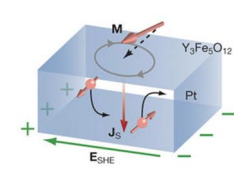 Electronic materials
Electronic materials
JST ERATO Spin Quantum Rectification
Spin Current and Spintronics A New Horizon of Spin Science- Observation

-

-

-

- The discovery of basic phenomena in solids related to spin current
- Significant progress made in techniques for measuring spin current
- New potential for spin current in thermal and nanomechanical applications
Anticipated applications for spintronics in memory and hard disk drives
In addition to possessing electric charge, electrons have a magnetic property called “spin.” The field that studies new physical phenomena associated with spin and engineering applications that employ both properties of the electron is called “spintronics.” This field has already developed applications in storage media and energy-efficient computer technologies.
Spin current refers to the flow of electrons’ spin angular momentum in matter (Figure 1). In 2008 we discovered a basic phenomenon of spin current called the inverse spin Hall effect, which has made it possible to detect spin current and convert it into electricity. We also discovered a method of thermoelectric generation based on entirely new quantum principles involving spin currents. Long-known thermoelectric conversion phenomena, such as the Seebeck effect and the Peltier effect, appear in systems with temperature gradients. The heat flux produced in these systems generates a spin current. This phenomenon is called the spin Seebeck effect. The generated spin current is converted to electric voltage through the inverse spin Hall effect. This phenomenon is garnering attention as a new principle of thermoelectric conversion that uses spin rectification. Thermoelectric conversion devices based on these spin Seebeck devices are theoretically expected to surpass the performance of conventional thermoelectric devices.
Elucidating various phenomena related to spin currents and suggesting new principles of use
Our research conducted thus far has clarified a variety of physical phenomena in solids that are caused by spin currents (Figure 2). Moreover, these spin-current-related phenomena are now being used in techniques for studying spin properties in solids. Techniques for measuring spin dynamics based on spin current in particular have made considerable progress in recent years. Now, no longer confined to just electronic properties, the arena of spin current activity has expanded to include such systems as nanomechanical motion and microfluidics.

Figure 1 The concept of spin current

Figure 2 Discovery of basic phenomena in solids related to spin currents

Eiji Saitoh
Institute for Materials Research
Advanced Institute for Materials Research
Tohoku University
References:
- [1] E. Saitoh, M. Ueda, H. Miyajima, and G. Tatara; Appl. Phys. Lett., 88, 182509 (2006).
- [2] K. Uchida, S. Takahashi, K. Harii, J. Ieda, W. Koshibae, K. Ando, S. Maekawa, and E. Saitoh; Nature, 455, 778-781 (2008).
- [3] R. Takahashi, M. Matsuo, M. Ono, K. Harii, H. Chudo, S. Okayasu, J. Ieda, S. Takahashi, S. Maekawa and E. Saitoh; Nat. Phys., 12, 52–56 (2016).